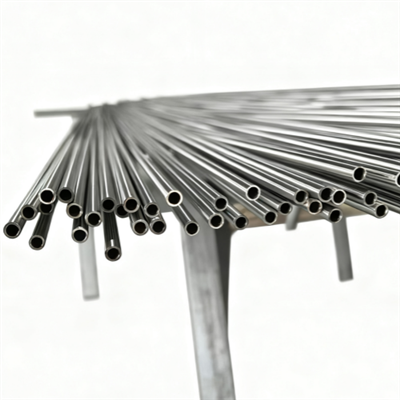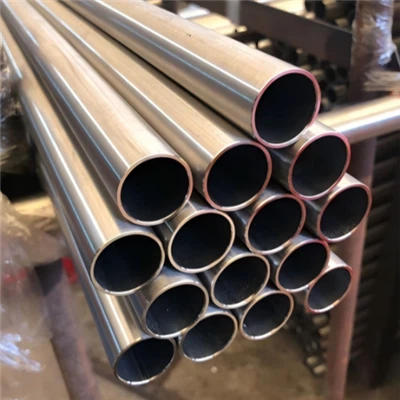As a trusted supplier of Stainless Coil Tubing, I am often asked about the intricate process of manufacturing these essential components. In this blog post, I'll take you through the detailed steps involved in producing high - quality stainless coil tubing, from the raw materials to the final product.
Raw Material Selection
The first and most crucial step in manufacturing stainless coil tubing is the selection of raw materials. Stainless steel is the primary material, and it comes in various grades, each with its unique properties. For instance, SS316Ti UNS S31635 is a popular choice due to its excellent corrosion resistance, high strength, and good weldability. This grade contains titanium, which helps to prevent carbide precipitation during welding, making it suitable for applications in harsh environments such as chemical processing plants and marine settings.


The raw materials are typically sourced from reliable steel mills. These mills ensure that the stainless steel meets strict quality standards. The steel is usually in the form of large coils or sheets, which are then transported to our manufacturing facility for further processing.
Melting and Refining
Once the raw materials arrive at our plant, the next step is melting and refining. The stainless steel coils or sheets are loaded into electric arc furnaces. These furnaces use high - intensity electric arcs to heat the steel to extremely high temperatures, typically around 1600°C (2912°F). This process not only melts the steel but also allows for the removal of impurities.
During the melting process, various alloying elements are added to the molten steel to achieve the desired chemical composition. For example, chromium is added to enhance corrosion resistance, while nickel improves ductility and toughness. After the initial melting, the steel undergoes a refining process. This can involve methods such as ladle refining, where additional purification steps are carried out to further reduce impurities and adjust the chemical composition precisely.
Forming the Tubing
After the steel has been melted and refined, it is time to form it into tubing. There are two main methods for forming stainless coil tubing: seamless and welded.
Seamless Tubing
Seamless tubing is made by piercing a solid billet of stainless steel. The billet is first heated to a high temperature and then placed in a piercing mill. A mandrel is inserted into the center of the billet, and as the billet rotates, it is forced over the mandrel, creating a hollow tube. This process results in a tube with a uniform wall thickness and no weld seam, which makes it ideal for applications where high pressure and reliability are required, such as in the oil and gas industry.
Welded Tubing
Welded tubing, on the other hand, is made by rolling a flat strip of stainless steel into a tubular shape and then welding the edges together. There are different welding methods available, including TIG (Tungsten Inert Gas) welding and laser welding. TIG welding is a popular choice as it provides a high - quality, clean weld. Laser welding, on the other hand, offers faster welding speeds and greater precision. Welded tubing is often more cost - effective than seamless tubing and is suitable for a wide range of applications, including plumbing and structural uses.
Cold Drawing and Annealing
After the tubing has been formed, it usually undergoes a cold - drawing process. Cold drawing involves pulling the tubing through a series of dies to reduce its diameter and increase its wall thickness. This process improves the surface finish of the tubing and enhances its mechanical properties, such as strength and hardness.
Following cold drawing, the tubing is annealed. Annealing is a heat - treatment process where the tubing is heated to a specific temperature and then slowly cooled. This process relieves internal stresses in the tubing, improves its ductility, and restores its corrosion - resistance properties. The annealing temperature and time depend on the grade of stainless steel and the specific requirements of the tubing.
Coiling
Once the tubing has been cold - drawn and annealed, it is ready to be coiled. Coiling is an important step as it allows for easy storage, transportation, and installation of the tubing. The tubing is fed through a coiling machine, which winds it into a tight coil. The coiling process must be carefully controlled to ensure that the coil has a consistent diameter and pitch.
Surface Treatment
After coiling, the stainless coil tubing may undergo surface treatment. This can include processes such as pickling and passivation. Pickling involves immersing the tubing in an acid solution to remove any scale or oxide layers that may have formed during the manufacturing process. Passivation, on the other hand, is a chemical treatment that forms a thin, protective oxide layer on the surface of the tubing, further enhancing its corrosion resistance.
Quality Control
Throughout the entire manufacturing process, strict quality control measures are in place. We use a variety of testing methods to ensure that the stainless coil tubing meets our high - quality standards. These tests include non - destructive testing methods such as ultrasonic testing, which can detect internal defects in the tubing, and eddy - current testing, which can identify surface and near - surface defects.
In addition, we also perform mechanical testing, such as tensile testing and hardness testing, to ensure that the tubing has the required mechanical properties. Chemical analysis is also carried out to verify that the chemical composition of the tubing is within the specified range.
Packaging and Shipping
Once the stainless coil tubing has passed all the quality control tests, it is ready for packaging and shipping. The coils are carefully wrapped in protective materials to prevent damage during transportation. They are then loaded onto trucks, trains, or ships and sent to our customers around the world.
Applications of Stainless Coil Tubing
Stainless coil tubing has a wide range of applications across various industries. In the automotive industry, it is used for fuel lines, brake lines, and exhaust systems. In the food and beverage industry, Stainless Steel Coil Tubes are used for conveying liquids and gases due to their hygienic properties. In the construction industry, they can be used for structural applications and plumbing systems.
Another interesting application is in the aerospace industry, where the high strength - to - weight ratio and corrosion resistance of stainless coil tubing make it suitable for use in aircraft hydraulic systems and fuel lines.
Conclusion
Manufacturing stainless coil tubing is a complex and highly regulated process that requires precision and expertise at every step. From the selection of raw materials to the final quality control checks, we are committed to producing the highest - quality tubing for our customers.
If you are in the market for high - quality stainless coil tubing, we would love to hear from you. Whether you need Hexagonal Stainless Steel Pipe for a unique project or standard stainless coil tubing for a more common application, we have the products and expertise to meet your needs. Contact us today to discuss your requirements and start a procurement negotiation.
References
- ASM Handbook, Volume 1: Properties and Selection: Irons, Steels, and High - Performance Alloys.
- Stainless Steel Handbook, edited by James R. Davis.
- Manufacturing Processes for Engineering Materials, by Serope Kalpakjian and Steven R. Schmid.






